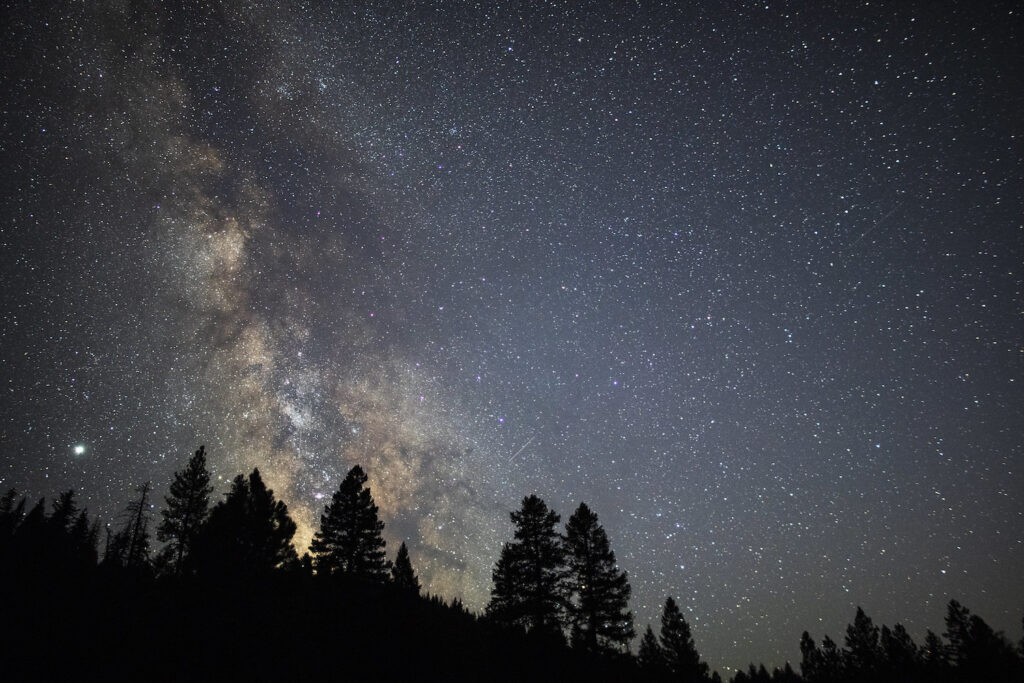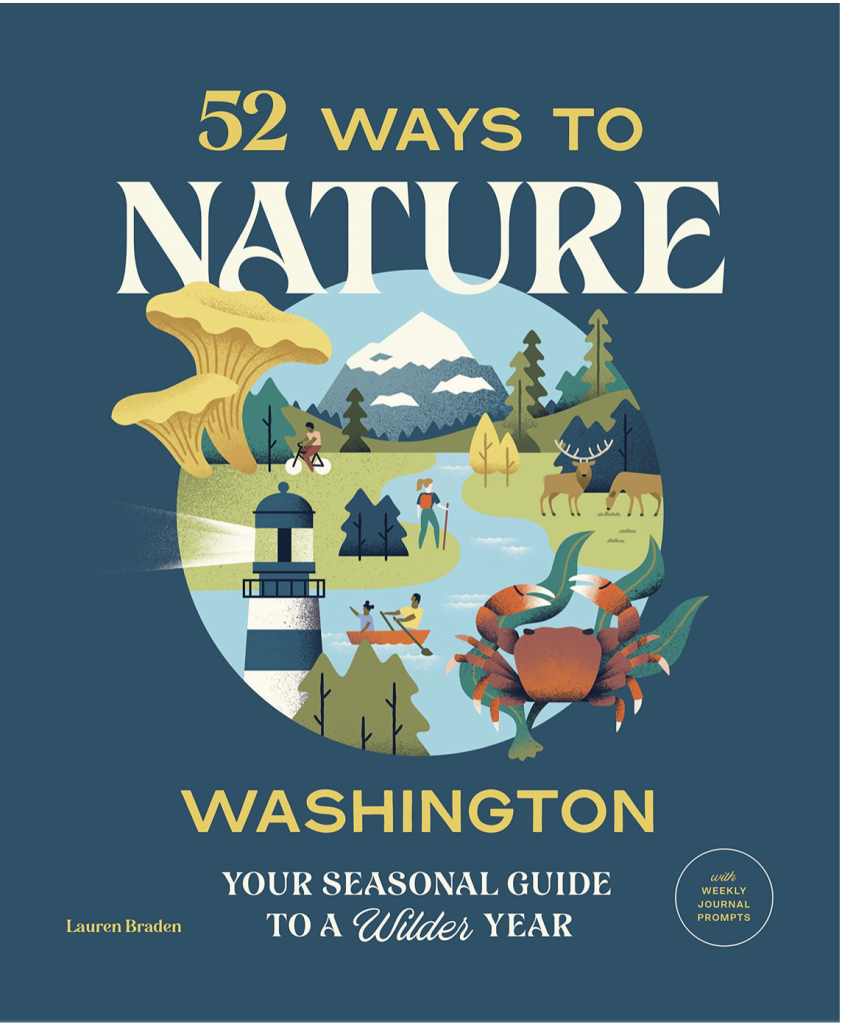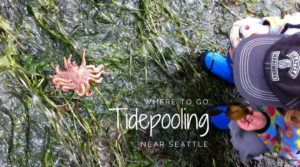NOTE: This article is an excerpt from the book 52 Ways to Nature, Washington: Your Seasonal Guide to a Wilder Year published by Mountaineers Books. Buy the book here.
Behold the night sky! See a meteor shower, view the full moon, piece together constellations and spot the Northern Lights–all in the Pacific Northwest.
On a clear summer night at dusk, go outside and look up. Even in the city, a few of the brightest stars and planets will peer back at you like tiny lanterns. As the sky darkens, twinkling stars appear faster than you can count them. Your eyes might piece together familiar constellations—formations named for gods and mythical creatures by the ancient Greeks, each accompanied by a story. The stars don’t move, but we do; as Earth spins and rotates around the sun, our Pacific Northwest view of the stars shifts.
Gazing at the vast night sky can be grounding, particularly in uncertain times. Take notice as the moon changes over the month from full to a waning gibbous to a new moon to a waxing crescent. The moon’s phases are so predictable they can be forecast fifty million years into the future. Some watch the stars and planets for existential pondering–the universe reveals its deepest mysteries to us if we are curious and courageous enough to explore it.
With some basic stargazing know-how, you’ve got a new after-dark pastime on your camping trips, and even in your backyard. Stars, planets, the moon and meteors are visible from almost anywhere, but you’ll see far more of them away from the light pollution of urban areas. Choose a night distant from a full moon–you’ve got a twelve-day window that’s ideal. Here’s how to get started.
Find Constellations
Constellations organize the sky into a celestial map. Head out on a moonless night and use a stargazing app like SkyMap that displays stars, planets and constellations as you point your smartphone around the night sky (use the dimmest setting so your eyes adjust well to the dark). Find the most recognizable shape in the northern night sky–the Big Dipper. It looks like a soup ladle and is not a constellation itself but is part of Ursa Major, the great bear. With your eyes, draw a straight line through the two outer stars of the ladle (they’re called Merak and Dubhe) and extend that imaginary line beyond the ladle’s lid–it points to Polaris, the North Star, and the last star of the Little Dipper’s handle. From here, make out other constellations like Cassiopeia, Cepheus and Draco.
View the Moon
You need only binoculars and a full moon (or close to it) to view its whole surface up close–a tapestry of mountains, craters and vast, dark seas called mares, ancient lava beds that early astronomers mistook for seas. The lightest areas are lunar highlands, or mountains. Do you see a prominent crater near the moon’s south pole with radiating rays? This is is Tycho. The moon’s craters, formed when asteroids and meteorites crashed into its surface, lend it that Swiss cheese appearance. Unlike Earth, the moon has no atmosphere to burn them up before they collide. Notice how the moon’s surface appears static, night after night? From earth we always see the same side of it, and rely on satellite images to know what’s on the other side. At moonrise, you’ll see the most detail and relief on the moon’s surface. Find the moon phase calendar at stardate.org.
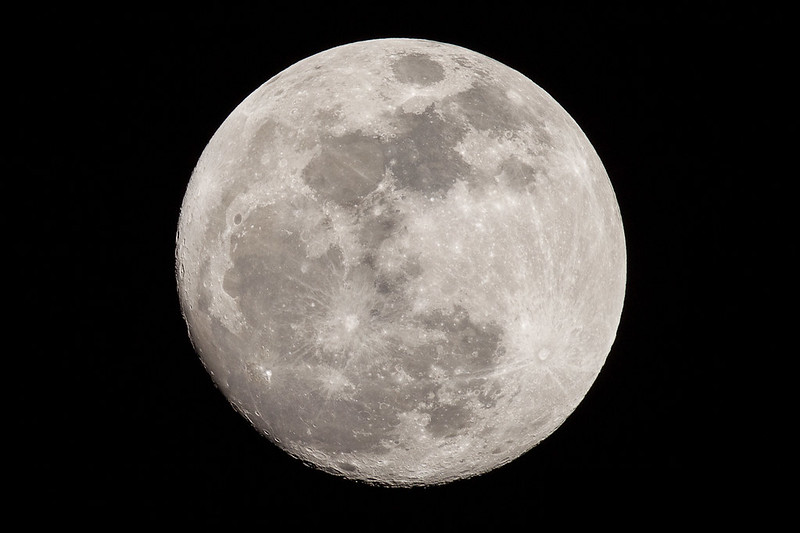
See the Milky Way
Nearly everything you see in the night sky without a telescope is part of the Milky Way galaxy. But unless you’re in the right place at the right time, you’ve perhaps never seen the Milky Way in all its glory–a stunning, nebulous band of glowing light in the night sky comprising billions of stars. Earth sits on the outer edge of the densest part, so we have a stellar view. You need very dark, clear, summer skies to see the Milky Way—search for the darkest skies during a new moon to experience this astral wonder.
Watch the Perseid Meteor Shower
What are you doing at night the second week of August? Look up! A meteor shower occurs when Earth passes through a stream of cosmic debris (meteoroids) that hit Earth’s atmosphere at high speeds, burning up on entry and giving off a shooting stream of bright light (hence their nickname, “shooting stars”). The Perseids are remnants of the comet Swift–Tuttle. This shower typically peaks from August 11-13 every summer. If this coincides with a full moon, set your alarm and look for meteors in the dark hour before dawn. To see dozens of meteors, flee the city’s lights and spread out a blanket, lie down, and gaze up. Once your eyes adjust, you’ll start to see meteors in various places in the sky.
Spot the Northern Lights
The Aurora Borealis is the sky’s natural light show—a glowing display of reds, greens and blues caused by geomagnetic solar storms on the sun. These storms eject charged particles like ions and electrons into space. Earth’s magnetosphere repels most of them, but this protection is weakest at the North and South Poles. When the charged particles interact with nitrogen and oxygen, they expel photons; the result is a wash of color in the night sky, with different hues tied to various levels of the atmosphere. To see this celestial phenomenon for yourself, you have to be in the right place at the right time, with an open view to the north along the horizon. Aurora chasers check with NOAA’s Space Weather Prediction Center for the nightly Aurora forecast.
Where to Find Dark Skies
Washington’s darkest skies are found in large swaths of public land, such as national parks and forests. High meadows and ridges at treeline in the Olympics and Cascades are prime stargazing locales. Darksitefinder.com can help you find other areas free of light pollution. Here are some top spots.
The Olympic Coast: Pitch a tent on an Olympic National Park beach and gaze the night away. The darkest skies in the state are wide open over the Pacific Ocean, so there’s no better place to watch a meteor shower.
Artist Point: On a clear night with little-to-no moon, drive-to this stellar vista of the cosmos at 5,000 feet elevation tucked between Mt. Skuksan and Mt. Baker.
Sunrise: This spot on the east slope of Mt. Rainier has zero light pollution and sits above treeline so you have a wide open sky, perfect for spying meteors or gawking at the Milky Way.
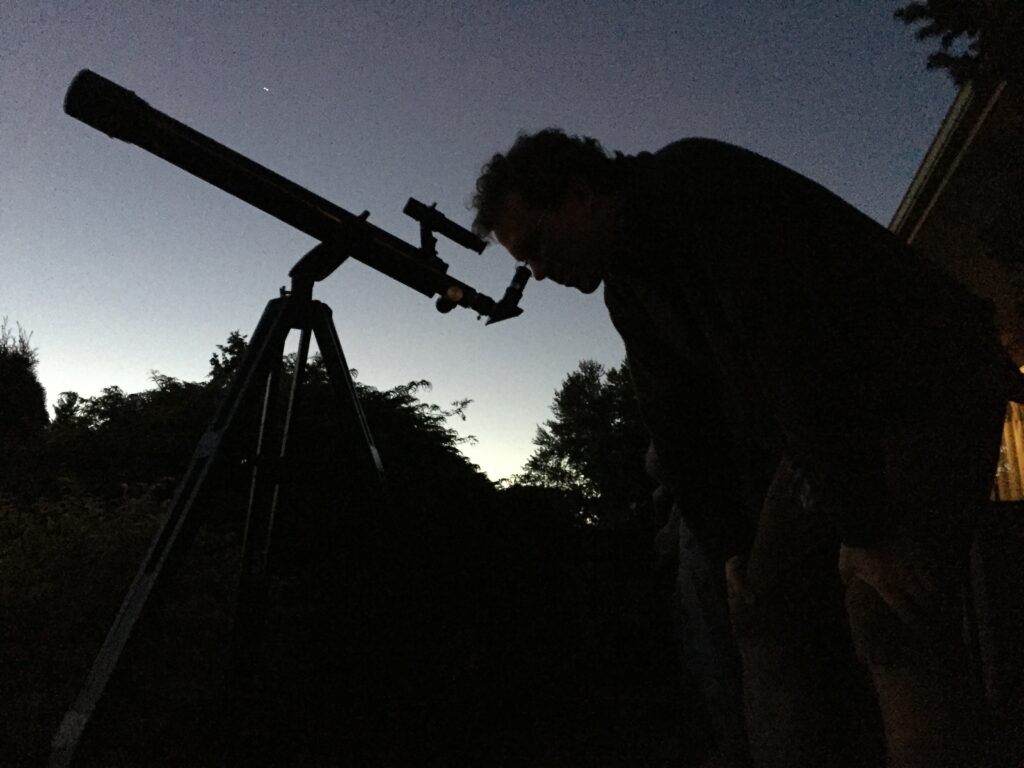
Observatories
Theodor Jacobsen Observatory, University of Washington campus in Seattle. Built in 1895 with a refracting telescope from the same era, this campus observatory in the UW Astronomy Department frequently opens its doors to non-students for free open houses and astronomy talks. depts.washington.edu/astron.
Edwin E. Richie Observatory, Bainbridge Island. See the night sky through the largest publicly accessible telescope in the region, and stay for cosmic talks with the Battle Point Astronomical Association in their planetarium. bpastro.org.
Goldendale Observatory State Park Heritage Site, Goldendale. The wide open skies of Eastern Washington look pretty amazing through this giant hilltop telescope. Come here to see the northern lights during geomagnetic storms. goldendaleobservatory.com, Discover Pass required.
Learn More About the Night Sky
Get a night sky app for your smartphone or tablet. Sky Map and Sky Guide are both excellent options.
The Seattle Astronomical Society holds several “star party” field trips a month around the city and nearby suburbs, led by expert astronomers. seattleastro.org
Connect with Dark Skies Northwest, our local chapter of the International Dark Sky Association. They work to solve the problem of light pollution to preserve our beautiful night sky.
Listen to Stardate online or on National Public Radio. It’s a daily audio segment on cool space facts and current astronomical events.
For Your Nature Notebook
Gazing at the night sky reminds us that although we are small compared to the universe, we are a part of it; the brightest, furthest stars are made up of the same thing we are–stardust. In what ways do you feel connected to the cosmos?
This article is an excerpt from the book:
52 Ways to Nature, Washington: Your Seasonal Guide to a Wilder Year
published by Mountaineers Books.
Buy the book here.
PHOTO CREDITS:
The Milky Way above Jenny Creek in Oregon’s Cascade-Siskiyou National Monument, courtesy of BLM via Flickr Creative Commons.
Super moon by Syed Ali, courtesy of Flickr Creative Commons.
Gazing through a telescope by Lauren Braden.

